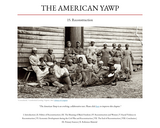
A chapter from The American Yawp open source history textbook focusing on, "Reconstruction."
- Subject:
- Social Studies
- Material Type:
- Textbook
- Author:
- Ben Wright
- Joseph Locke
- The American Yawp
- Date Added:
- 04/02/2020

A chapter from The American Yawp open source history textbook focusing on, "Reconstruction."
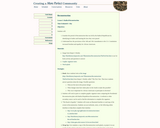
In this lesson, students examine the period of Reconstruction that was led by the Radical Republicans by identifying the leaders and the laws that were passed. They will also understand how the provisions of the 14th and 15th amendments to the U.S. Constitution increased freedom and equality for African Americans.
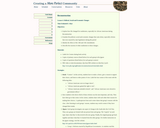
In this lesson, students explore how life changed for southerners, especially for African Americans during Reconstruction. They will examine reforms that were enacted by state legislatures during this period and identify the effects of the 14th and 15th amendments.
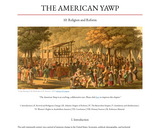
A chapter from The American Yawp open source history textbook focusing on, "Religion and Reform."
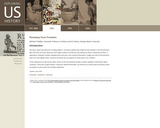
In this assignment students will use the online version of the Pennsylvania Gazette to build a database of information about runaways, those who sought freedom. Using this collected information, they will then try to draw useful conclusions about the people on whose labor the revolution depended. Students will write a three page analysis of the data.
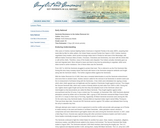
In this lesson, students will be able to compare Cherokee experience with Seminole experience under the Indian Removal Act and make inferences about different points of view of the Second Seminole War using primary documents, assuming a role of historical figure in the war and by role playing an interview with Harper's Weekly Reporter.
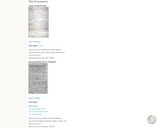
This resource identifies and provides primary source documents associated with the Sioux Treaty of 1868.

These activity suggestions can be used when teaching about the Sioux Treaty of 1868, using primary source documents.
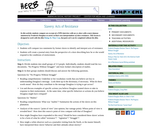
Students compare an excerpt of a WPA interview with an ex-slave with a more famous statement by Frederick Douglass to arrive at their own interpretations of slave resistance. This lesson is designed to work with the film Doing As They Can, but parts of it can be completed without the film.

With this digital collection, students will examine documents that bring together arguments for emancipation written before, during, and after the Civil War. The collection allows students to trace the evolution of abolitionist arguments as well as to examine conflicts among writers over what emancipation would entail. Students will keep the following questions in mind as they review the documents: 1. What arguments did writers make before the Civil War for the abolition of slavery? How did they frame their appeals in moral, social, political, and economic terms? 2. How did the war’s purpose shift from “saving the union” to destroying slavery? 3. What would freedom mean for former slaves, for Southern society, and for the nation as a whole, according to various writers both before and after the war?

In this activity, students view and analyze primary source documents in order to answer a series of questions about opposing views on slavery.
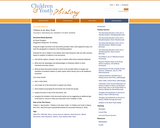
In this writing activity, students use the images and texts in the documents provided to write a well-organized essay of at least five paragraphs in response to the following question: Evaluate the role of children in the Atlantic slave trade during the 18th and 19th centuries, based on analysis of evidence in the documents.

In this lesson, students examine children's experiences in the trans-Atlantic slave trade in terms of their capture, transport, and usage as laborers. They will also assess factors in the continuation of the slave trade in the Americas, and in its fluctutation over time, and assess efforts by abolitionists to draw attention to the evils of slavery through publication of narratives and images involving children and the brutalities to which they were exposed.
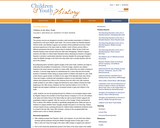
In this activity, students examine a series of primary source documents that are designed to provide a well-rounded examination of children's experiences in the trans-Atlantic slave trade. Each of the sources offers a different perspective. By juxtaposing these narratives against images of the slave trade, students can begin to understand the brutalities of enslavement. A set of discussion questions is provided.

In this lesson students read a series of documents about the American and Mexican reasons for and against the 1846 U.S.-Mexico War. As they read the documents students identify when the authors employ various foreign policy ideologies such as Manifest Destiny, Racial and Cultural Superiority, and Self Defense. This lesson was designed to be implemented with a Smartboard, but it can be completed without this technology.

Students will examine several documents related to the life of Solomon Northup, whose life story is told in his autobiography Twelve Years a Slave: Narrative of Solomon Northup, a Citizen of New-York, Kidnapped in Washington City in 1841 and Rescued in 1853, from a Cotton Plantation Near the Red River in Louisiana.
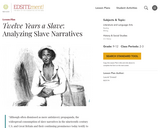
The corrupting influence of slavery on marriage and the family is a predominant theme in Solomon Northup's narrative Twelve Years a Slave. In this lesson, students are asked to identify and analyze narrative passages that provide evidence for how slavery undermined and perverted these social institutions. Northup collaborated with a white ghostwriter, David Wilson. Students will read the preface and identify and analyze statements Wilson makes to prove the narrative is true.

This lesson uses "Uncle Tom’s Cabin & American Culture: A Multimedia Archive" (www.iath.virginia.edu/utc) to examine the sectional crisis of the 1850s, as well as slavery and the mindset of Southern planters during the Antebellum Era. In completing the assignment, students are required to analyze not only traditional text documents but also a selection of audio and visual sources.
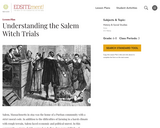
In 1691, a group of girls from Salem, Massachusetts accused an Indian slave named Tituba of witchcraft, igniting a hunt for witches that left 19 men and women hanged, one man pressed to death, and over 150 more people in prison awaiting a trial. In this lesson, students will explore the characteristics of the Puritan community in Salem, learn about the Salem Witchcraft Trials, and try to understand how and why this event occurred.
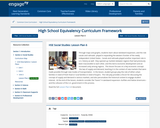
In the lesson, student groups play the role of either urban families in need of fresh food or rural families in need of buyers. The role play provides a forum for discussing the concept of supply and demand in various markets, and also personalizes the historical context to engage student interest. At the end of the lesson, students consider the “losers†in westward expansion--buffalo and Native Americans--and the collusion of the U.S. government in this process.